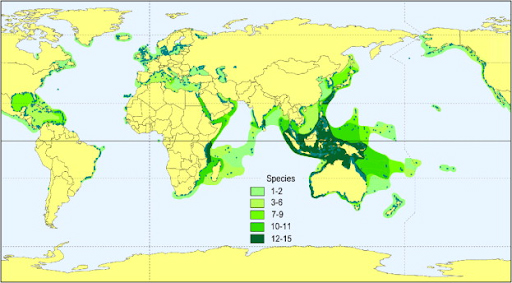Ecology
What are seagrasses?
Seagrasses are a group of underwater plant species that resemble their terrestrial counterparts. Seagrasses can be found all over the world, but are generally limited to coastal waters since they are restricted by depth due to an important need for sunlight. Despite this, seagrasses are unrivaled in terms of productivity, creating some of the most unique and important ecosystems around the world.
Why are seagrasses important?
Seagrasses are known as “ecosystem engineers” due to their impact on shaping and modifying their local environments. One major service that seagrasses provide to their environment is blue carbon sequestration. Much in the same way trees remove carbon dioxide from the atmosphere, the blue carbon sequestration performed by seagrasses removes carbon dioxide from the ocean, mitigating ocean acidification. Dissolved carbon dioxide causes increased ocean acidity, which harms aquatic life. The blue carbon sequestered from coastal and marine ecosystems into seagrasses effectively converts harmful dissolved carbon dioxide into useful vegetative biomass.

Seagrass species distribution across the world, as reported by the Journal of Experimental Marine Biology and Ecology
Seagrasses play a critical role in maintaining the health of local marine ecosystems. Due to carbon sequestration, seagrass is a nutritious food source for animals such as sea turtles, manatees, dugongs, and migratory birds, thus influencing larger marine ecosystems around the world. Moreover, seagrass meadows serve as shelter for smaller marine animals such as shrimp, crabs, and fish larvae. Countless species rely on seagrasses, and many would find their survival in jeopardy if seagrasses were removed.
What threatens seagrass health?
Seagrasses are vulnerable to mass destruction and eradication. Human activity contributes to climate change, coastal development, and decreasing water quality, which threaten both seagrass populations and the species that rely on these marine ecosystems. Eutrophication is one of the most critical threats to seagrass. Eutrophication is the excessive growth of algae in bodies of water due to an influx of nutrients. Algal growth deoxygenates the local environment (effectively suffocating the local wildlife) and blocks sunlight to photosynthetic plants. The loss of this keystone species will damage all tiers of the ecosystem and also impact the organisms that rely on its services. Additionally, the elimination of seagrasses would have a significant economic impact, valued at a loss of US $19,002 per hectare per year.1

Various threats to seagrass ecosystems and the resulting consequences of habitat destruction, sourced from ScienceMag